Buchan Parishes and the Buchan Combination, Aberdeenshire
Buchan, an historic district and earldom at the north-east corner or Aberdeenshire, had one of Scotland's greatest concentrations of parochial poorhouses or almshouses. Many of these appear to have continued in operation after the opening of the Buchan Combination poorhouse in 1869.
The Auchterless parish house was situated about half a mile to the north-east of Thomastown. The building, presumably a small cottage, is not identified as a poorhouse on the first edition Ordnance Survey (OS) map (1871) but is so marked on the 1901 and 1928 revisions. The building no longer exists.
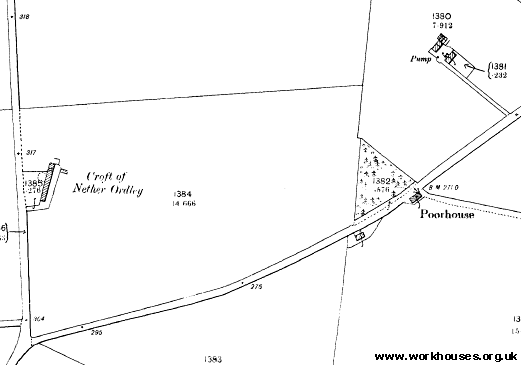
Auchterless poorhouse site, 1901.
The Crimond parish house was located about a mile to the south-west of Crimond and is shown on on the first and second edition OS maps of 1872 and 1902. The building no longer exists.
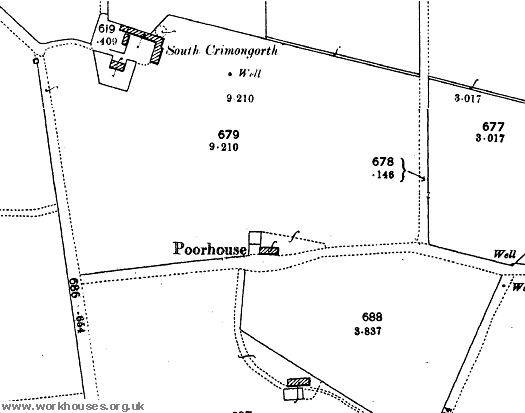
Crimond poorhouse site, 1902.
Cruden's parish house was located about a mile to the north-east of Hatton. The establishment is indicated as a poorhouse on the first and second edition OS maps of 1869 and 1901. In 1904, the building could accommodate 3 men and three women under the care of a resident matron. The now much-enlarged building survives as Braco Cottage.
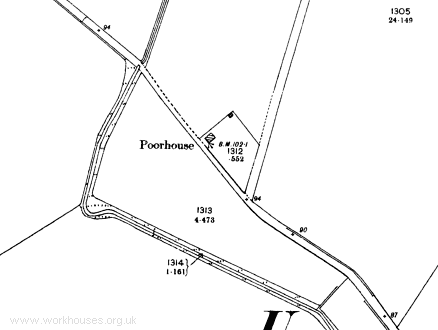
Cruden poorhouse site, 1902.
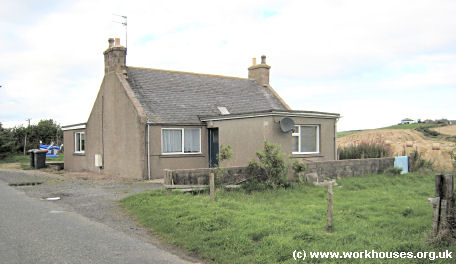
Cruden former poorhouse, 2009.
© Peter Higginbotham.
The New Deer parish house was located about a mile to the west of New Deer village and is shown on on the first and second edition OS maps of 1873 and 1901. In 1904, the building could accommodate up to 10 persons under the care of a resident matron. The building still exists and is survives as Cam Ranh Croft, although is also known as Turfhill Cottage.
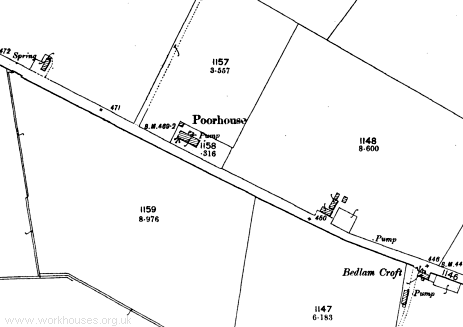
New Deer poorhouse site, 1901.
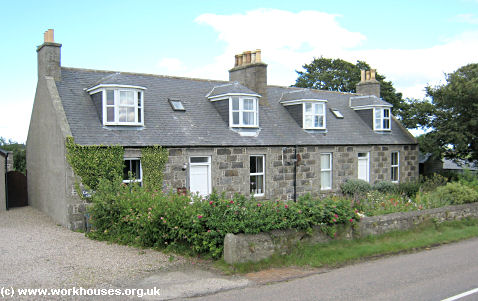
New Deer former poorhouse, 2009.
© Peter Higginbotham.
The Old Deer parish house stood near the centre of the village at the south side of Abbey Street. The premises, consisting of four separate cottages, were erected by the parochial board in around 1851 at a cost of £1,300 funded by the poor rate. In 1904, the building could accommodate up to 22 men and women, with four "attendants" in residence. The building no longer exists and the site is now occupied by ornamental gardens.
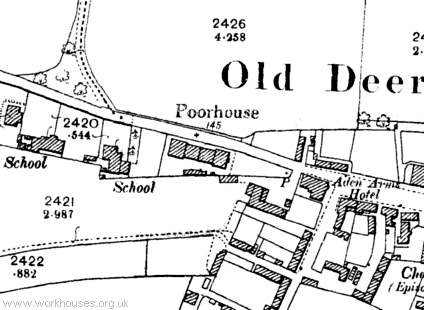
Old Deer poorhouse site, 1902.
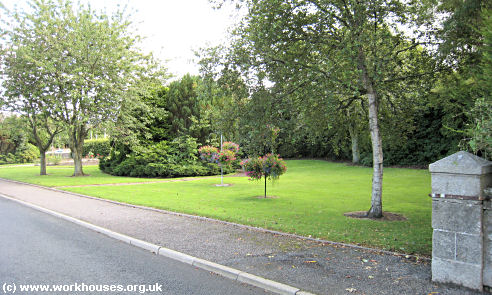
Old Deer former poorhouse site, 2009.
© Peter Higginbotham.
The parish house for Ellon was erected in 1849 at the junction of Park Road and Station Road in Ellon. The building was designed by architects James Matthews and Thomas Mackenzie. By 1904, it could accommodate up to 11 men and 11 women, under the care of a matron and her assistant. The premises later became the Ythanvale Nursing Home. The site was redeveloped in the mid-1980s and, now known as Andrew Fowler House, continues to provide residential care for the elderly.
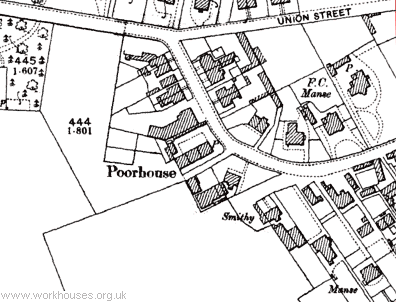
Ellon poorhouse site, 1900.
The Foveran parish house stood at the south of Newburgh, at the south-west corner of Udny Links. The building was erected by the parochial board in around 1854 and was still in use in 1904 when it could house two male and two female inmates. The building no longer exists.
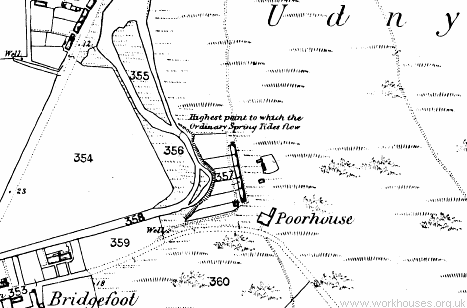
Foveran poorhouse site, 1867.
Fyvie's parish home was located at Lethenty, at the north side of the Moss of Windyhill. The building consisted of a row of seven cottages, the ones at each end being slightly larger. The accommodation was divided into twenty-four apartments with a resident attendant. The sole surviving section of the building, converted to use as a barn, appears to have rooms on two floors. A date-stone above the door on the west side indicates that the building was erected in 1860.
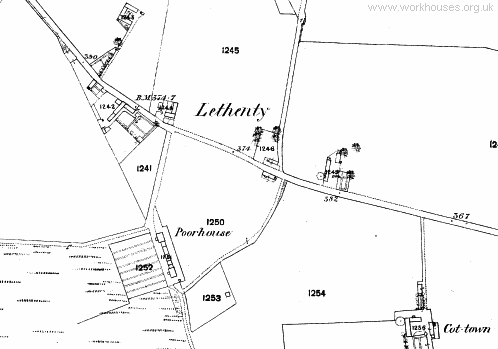
Fyvie poorhouse site, 1869.
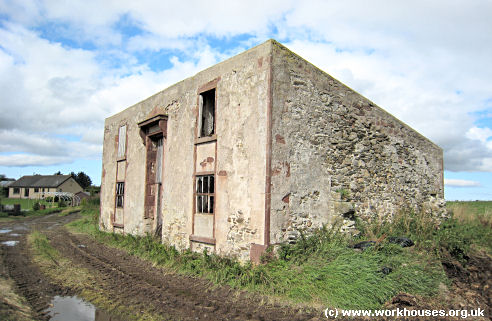
Fyvie former poorhouse site, 2009.
© Peter Higginbotham.
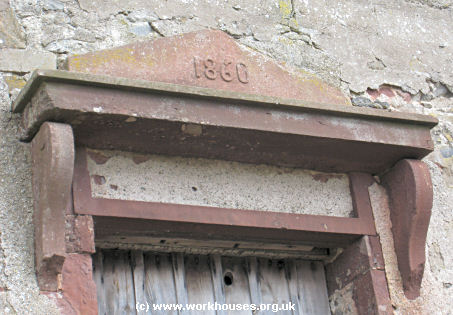
Fyvie former poorhouse site, 2009.
© Peter Higginbotham.
The King Edward parish house was situated about a mile to the south-west of Netherbrae. The long, presumably single-storey, building is marked as a poorhouse on only the first edition OS map of 1869. The building no longer exists.
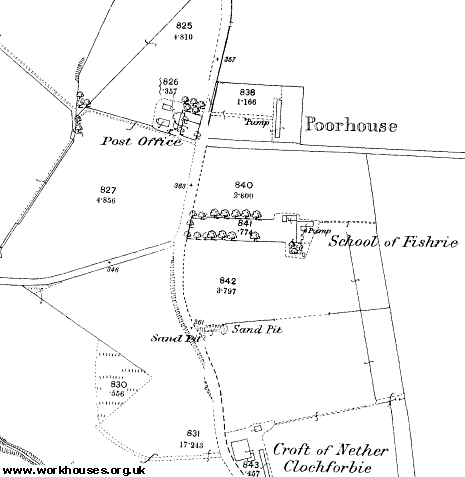
King Edward poorhouse site, 1869.
The Lonmay parish house, located about a mile to the north-east of New Leeds, was erected in around 1854 by the Parochial Board and Kirk Session. In 1904, the building could accommodate up to 4 men and 4 women plus an attendant. The building, now extended, is a private residence but still named "The Poor House".
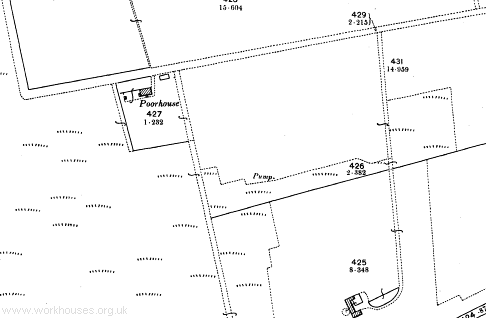
Lonmay New Leeds poorhouse site, 1902.
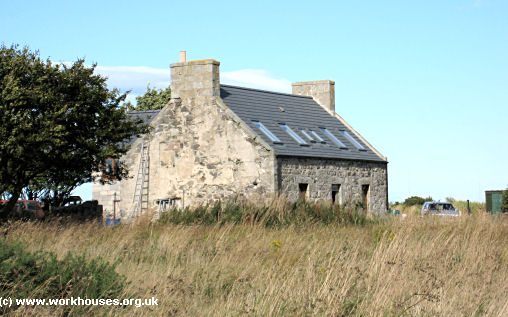
Lonmay former poorhouse, 2009.
© Peter Higginbotham.
Tarves had two parochial houses, one dating from 1847, the other from 1858. In 1904, the two establishments between them could house 8 men, 8 women, and 10 children. One of the houses was located at the east side of Red Moss, where Red Moss farm now stands. It appeared on the first edition OS map of 1870 as "Poorhouses". The building no longer exists.
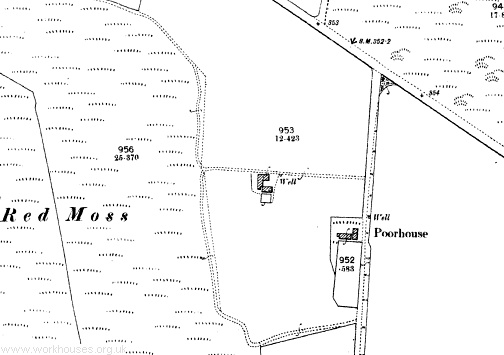
Tarves Red Moss poorhouse site, 1900.
The second Tarves poorhouse was situtaed at the south of Craigdam. It consisted of a single-storey block divided into four cottages. Although the building appears on the 1869 first edition OS map, it is not marked as a poorhouse until the 1900 second edition. The building, now Craigdam Cottages, was refurbished for residential use in the 1970s.
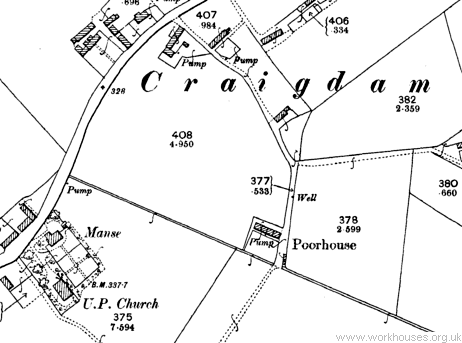
Tarves Craigdam poorhouse site, 1901.
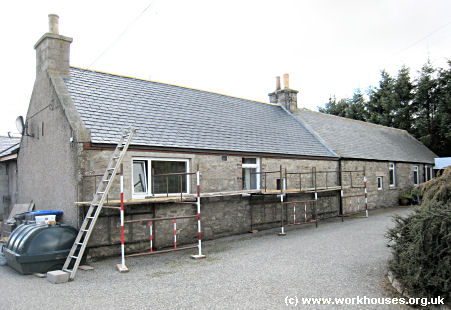
Tarves former Craigdam poorhouse, 2009.
© Peter Higginbotham.
The St Fergus parochial house, whose location is uncertain, was established in around 1864. By 1904, it housed up to 10 inmates.
Strichen had a parochial house from around 1867, location uncertain, rented for the purpose. It could accommodate 3 men, 3 women and 4 children.
Tyrie's parish poorhouse site was at New Pitsligo. It was built by the Parochial Board in around 1850 and could house 28 men or women. The building is thought to have been demolished in the 1960s.
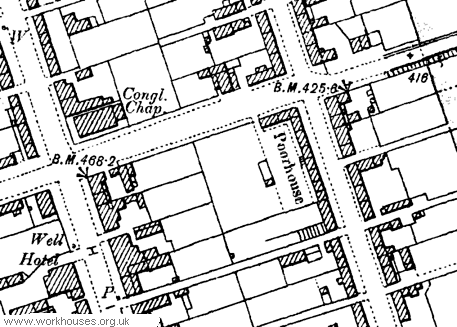
New Pitsligo poorhouse site, 1902.
The Turriff parish house, location uncertain, operated for many years in rented premises.
Udny had a parochial house from around 1860. Built by the parochial board, it could house 4 men and 5 women.
The Buchan Combination
The Buchan Combination was created in 1866 and initially comprised the sixteen parishes of Cruden, New Deer, Old Deer, Ellon, Fraserburgh, Logie-Buchan, Longside, Lonmay, Methlic, Monquhitter, Pitsligo, Rathen, Strichen, Tarves, Tyrie and Udny. Additions to the membership were Fyvie in around 1870; Crimond in 1871; Aberdour, Auchterless, Foveran, King Edward, St Fergus, anf Turriff in 1873; and Forglen and Slains in 1874. The total population of the member parishes in 1881 was 73,880.
Buchan erected a Combination poorhouse at Bank Road to the south of New Maud. Construction work took place in 1867-8 and the building opened in January 1869. Its location and layout are shown on the 1902 map below.
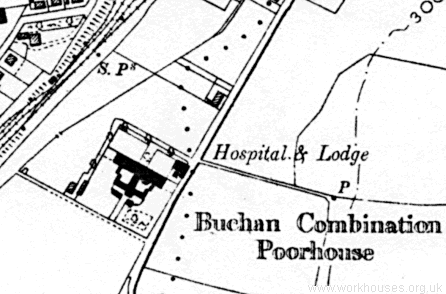
Buchan site, 1902
A porter's lodge stood at the entrance to the site.
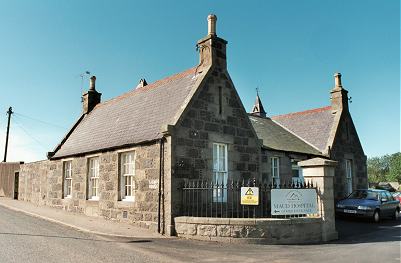
Buchan entrance lodge from the north-east, 2001.
© Peter Higginbotham.
The main building faced to the north-east.
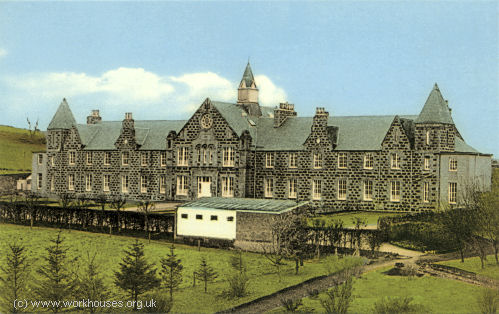
Buchan main building from the north, date unknown.
© Peter Higginbotham.
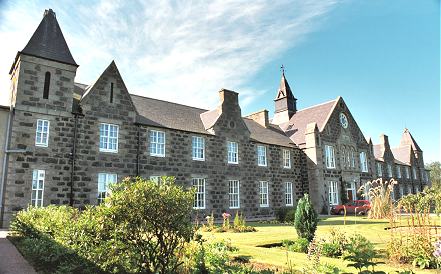
Buchan main building from the east, 2001.
© Peter Higginbotham.
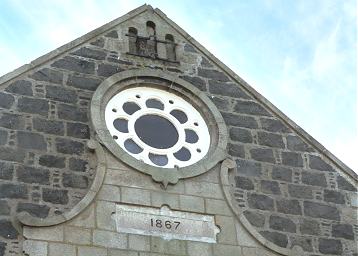
Buchan date plaque, 2001.
© Peter Higginbotham.
A central wing at the rear of the main building contained the dining-hall and kitchens. Other utility buildings and workshops lay at the rear of the site. These included milking parlour and piggeries.
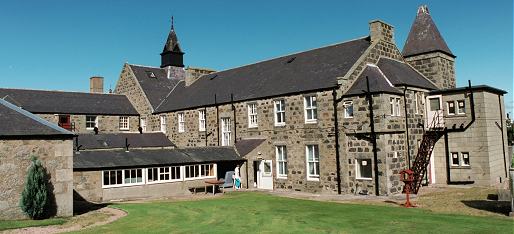
Buchan from the south-east, 2001.
© Peter Higginbotham.
The 1881 census indicates that two of the four poorhouse live-in staff were 'lunatic attendants' - one for women and one for men.
According to present-day staff, the grounds at the rear of the poorhouse were originally used for growing potatoes and oats. The land was ploughed by hand by a team of male inmates. The oats were taken for grinding at a local mill. The pathways were made from cinders from the poorhouse boilers.
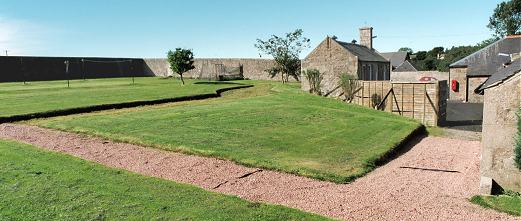
Buchan rear grounds from the east, 2001.
© Peter Higginbotham.
These staff recollections are very much in line with an article published in 1908 by the then Governor, Mr M Fraser, which was entitled Notes on the Mangement of a Poorhouse Farm:
|
These notes are meant to show how a small piece of land attached to an institution, where surplus labour is plentiful, may, by judicious management, be made to yield a substantial return, and at the same time provide congenial employment for the workers.
The land attached to this poorhouse comprises some twelve acres of very indifferent quality, and is in parts steep and difficult to work. All the labour is by the resident male lunatics, and is exclusively manual — that is, no horse labour is employed, the soil being all cultivated by spade, graip, and hoe; I work it on the 5-shift system — 2 grass, 1 oats, 1 turnips and 1 potatoes — this plan seems to me to be the most profitable where the institution absorbs practically the whole of the produce every year. The different shifts are deeply trenched alternately (that is, from grass to potato land), so that the whole of the twelve acres is trenched once in every five years. I seldom resort to artificial manure, except perhaps in the case of turnips and potatoes. I find the farm manure from the cows and pigs ample. The cesspool refuse I keep separate, and, mixed with soil and rubbish, it makes capital top-dressing, and raises splendid cabbages and other vegetables. There are 4 cows and from 6 to 8 pigs kept; and I try to regulate the time of calving, so that 3 of the cows are always in milk, which is charged to the institution at the rate of 9d. per gallon. For the past year the income from this source alone has been over a £100. The calves find a ready market, being in many cases sold before they are calved, as they have gained a local reputation for quality. The pigs are sold fat, and young ones are bought to replace them, as I find it more profitable to buy young pigs than to breed them. Potatoes are grown to the extent of about 10 tons per year; they are used in the house, and are charged at market rates. Cabbages, carrots and other vegetables are also grown in sufficient quantity for the requirements of the house, and charged at the rate of 3s. 6d. per cwt. In each year three acres of oats are grown, made into meal, and charged at the same rate as the meal supplied by contract. The labour of certain of the male lunatics is let out to farmers in the district, at a small rate per day. This forms a pleasant variety in their daily routine, and helps to augment the profits ; the income from this source for last year being £6, 2s. The lunatics, when employed on the land, get a lunch each forenoon, consisting of 4 oz. bread, with syrup or cheese, and occasionally a jug of table-beer. Appended is an abstract of income and expenditure for past year, showing a nett profit of £96, 16s. 1d. | |||
| INCOME. | EXPENDITURE. | ||
| £ s. d. | £ s. d. | ||
| Milk, 3423 galls. at 9d. | 128 7 3 | Value of stock at May 1, 1906 | 55 10 0 |
| Meal, 18 bolls at 12s: 8d. | 11 8 0 | Pigs bought | 9 18 0 |
| Potatoes, 11 tons at 50s. | 27 10 0 | Cows | 37 0 0 |
| Vegetables, 65 cwt. at 3s. 6d. | 11 7 6 | Straw and turnips | 18 14 6 |
| Pork, 8 stones at 7s. | 2 16 0 | Manure | 6 1 4 |
| Two cows sold | 17 10 11 | Cake and feeding stuffs | 11 14 8 |
| Four calves sold . | 11 14 0 | Seeds, farm and garden | 10 11 2 |
| Eleven pigs | 26 7 0 | Joiner work and tools | 3 8 7 |
| Patients' labour . | 6 2 0 | Sundries | 4 10 5 |
| Value of stock at May 1, 1907 | 48 0 0 | Feu-duty | 36 17 0 |
| Nett profit for year | 96 16 1 | ||
| £291 1 9 | £291 1 9 | ||
The institution was taken over by Aberdeen County Council in 1930 and became Maud Home. In 1946 an official report noted that it had a total of 160 beds for 'ordinary poor, harmless lunatics, mental defectives and chronic sick.' The building was described as having 'narrow dark central corridors, with dayrooms and dormitories on either side, enjoying neither cross light or cross ventilation'.
The home transferred to the National Health Service in 1948 as Maud Hospital and still provides care for the elderly.
Staff
Inmates
- Buchan Combination Poorhouse - 1881 Census
- New Deer Poors Lodging House, Turfhill - 1881 Census
- Old Deer Poors House - 1881 Census
- Ellon Poors Lodging House - 1881 Census
- Foveran Poorshouse - 1881 Census
- King Edward Poor House - 1881 Census
Records
Note: many repositories impose a closure period of up to 100 years for records identifying individuals. Before travelling a long distance, always check that the records you want to consult will be available.
-
Northern Health Services Archives, Special Collections Centre, The Sir Duncan Rice Library, Bedford Road Aberdeen AB24 3AA.
- Buchan Combination Poorhouse holdings include: Administrative records (1865-1981); Admissions and discharges (1869-1951).
-
Aberdeen City Archives, Town House, Broad Street, Aberdeen AB10 1AQ, and Old Aberdeen House, Dunbar Street, Aberdeen AB24 3UJ.
- Old Deer: Parochial Board minutes (1857-1930)
- Ellon: Parochial Board minutes (1861-80, 1902-30)
- Fyvie: Parochial Board minutes (1861-1930)
- Lonmay: Parochial Board minutes (1847-1930)
- Tyrie: Parochial Board minutes (1851-1930)
Bibliography
- None.
Links
- None.
Unless otherwise indicated, this page () is copyright Peter Higginbotham. Contents may not be reproduced without permission.


